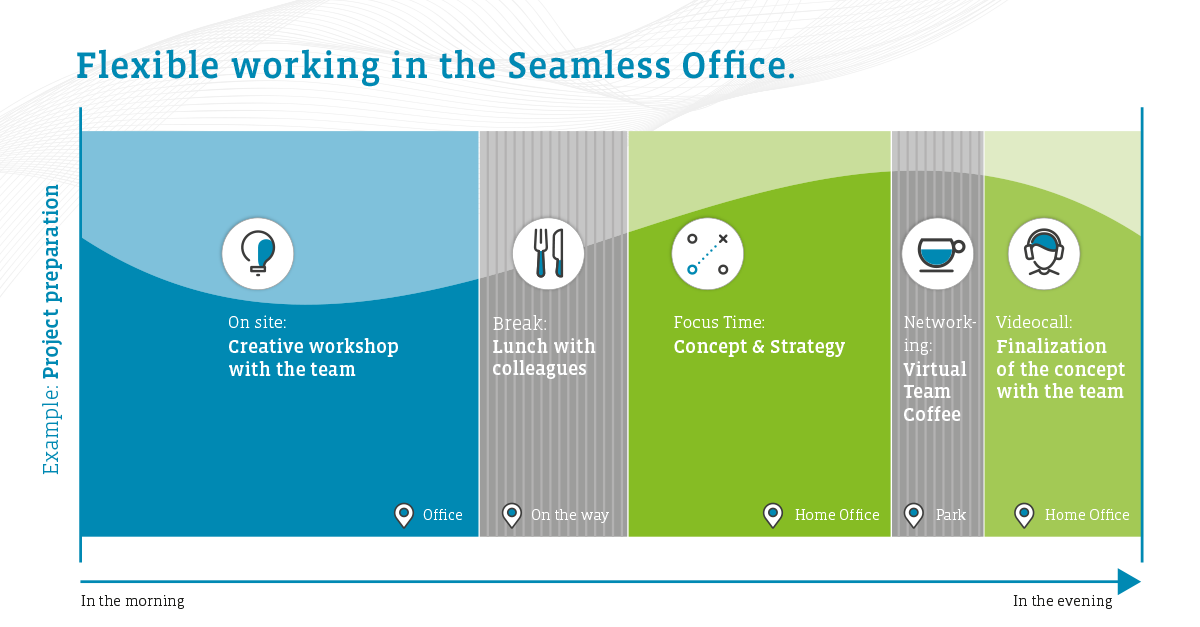It is not just the recent discussions surrounding the legal entitlement to work from home which have shown that conventional work models are about to change! But all too often, we only look at one aspect of this new challenge. This is not about one guaranteed day of working from home every two weeks, but rather about a fundamental question:
How do we want to design the way we will work in the future?
Our work is part of our life. It means that I have come to expect that my work environment will seamlessly adjust not only to my every-day situation but also to my current location. It is particularly the current coronavirus pandemic and the fast-growing case numbers that require us to re-evaluate our work locations. And to look at the bigger picture: At the core, this is not about the question of whether we need an office, but rather about how we can make the transitions in our work more fluid, and how we can change between work situations more easily.
The office is not a room but a state of being!
My wish: Regardless of the activities I am engaged in, I need a consistent environment for all of my work situations. Whether I am at home, on the road, in an on-line meeting or at my company sitting at my (flexible) work desk. I need tools that allow me to do my work at any time, and from anywhere.
This resulted in my idea of the Seamless Office: Find the work environment anywhere to collaborate in teams and to pause and resume work seamlessly. Vice versa, it also means: The Seamless Office makes it easier to temporarily stop your work, e.g. to look at your children’s homework or to make lunch with them.
When we think of the office, we think too much in terms of a specific space. But it is really more of a state of being. What type of support is ideal for working - regardless of where I am at the moment? And if this allows me to complete my tasks more effectively, I also have more time for other things: sports, creative downtime and especially family.
Where do companies have to invest?
Initially, Seamless Office denotes the right combination of software, a bit of hardware and services. Often, companies already have some of these - but they have not been integrated properly in terms of the three dimensions Toolset, Skillset and Mindset.
The Toolset must be configured in such a way that it covers all work situations and supports all work locations at the technological level. It is the foundation for creating a seamless experience. One example is the eBook, which opens on the right page regardless of the device (Notebook, eReader, smartphone). Another example: As a building block, the CS smartWorkspace also support seamless work activities. Employees can book work stations and meeting rooms using natural language. On full days, the solution will indicate whether it is worth going to the office, or whether it might be better to stay at home because too many rooms are already occupied.
But more important than the tools is investing in skills: Companies must establish the right skill set. At the center are the skills and self-assessment of the employees. The following must be considered and developed for each person: Where, how and when can I work in a way that is best for me? Where can I complete certain tasks in the most efficient way? What time of the day is used for which tasks?
What does my personal daily routine look like? In my own case, I now do all of my conceptual work in the home office or during extended train journeys (with my favorite music in the background). I use the office mainly for face-to-face meetings, for meeting customers, for internal meetings and ideally for informal discussions with colleagues. Let's take a concrete example, such as a customer project for finalizing a change management plan. It could look like this: Meeting in the office for a creative workshop with the team. Go out for lunch with the team and then head to the home office to work on the central theme and conceptual design. Finally, the team gets together remotely in the evening for a coordination meeting, and the results are presented to our customer via Microsoft Teams.
The final addition to the Toolset and Skillset is the right Mindset. Besides the Toolset (IT solutions) and Skillset (employee skills), companies must also establish the right Mindset and thus continue to develop the company's culture. The managers play the most important role in this context.
Working with their teams and employees, they must develop customized solutions:
- How can I combine the new requirements (e.g. extensive home office use) with my work style?
- What solutions can be developed to synchronize our activities and meet up regularly for social interaction? What does the team need?
- How can we promote even more forms of agile work?
- What can I do to ensure that I get enough breaks, that I am able to temporarily interrupt my work and maintain the required distance from my work?
- How can I better respond to the needs of my family or my partner?
The Seamless Office is more than just an office or technology. It is the right combination of Toolset, Skillset and Mindset.
The design of the Seamless Office creates sustainability
The Seamless Office as a design principle for the work environment is particularly suited for incorporating sustainability considerations. In this vein, the focus on sustainability means optimizing routes and work locations for face-to-face meetings. Commuters save resources (both in terms of fossil fuels and their nerves). Using solutions such as the CS smartWorkspace, offices can be used more efficiently and more effectively from an energy point of view. Hence the Seamless Office also leads to more balanced work.


